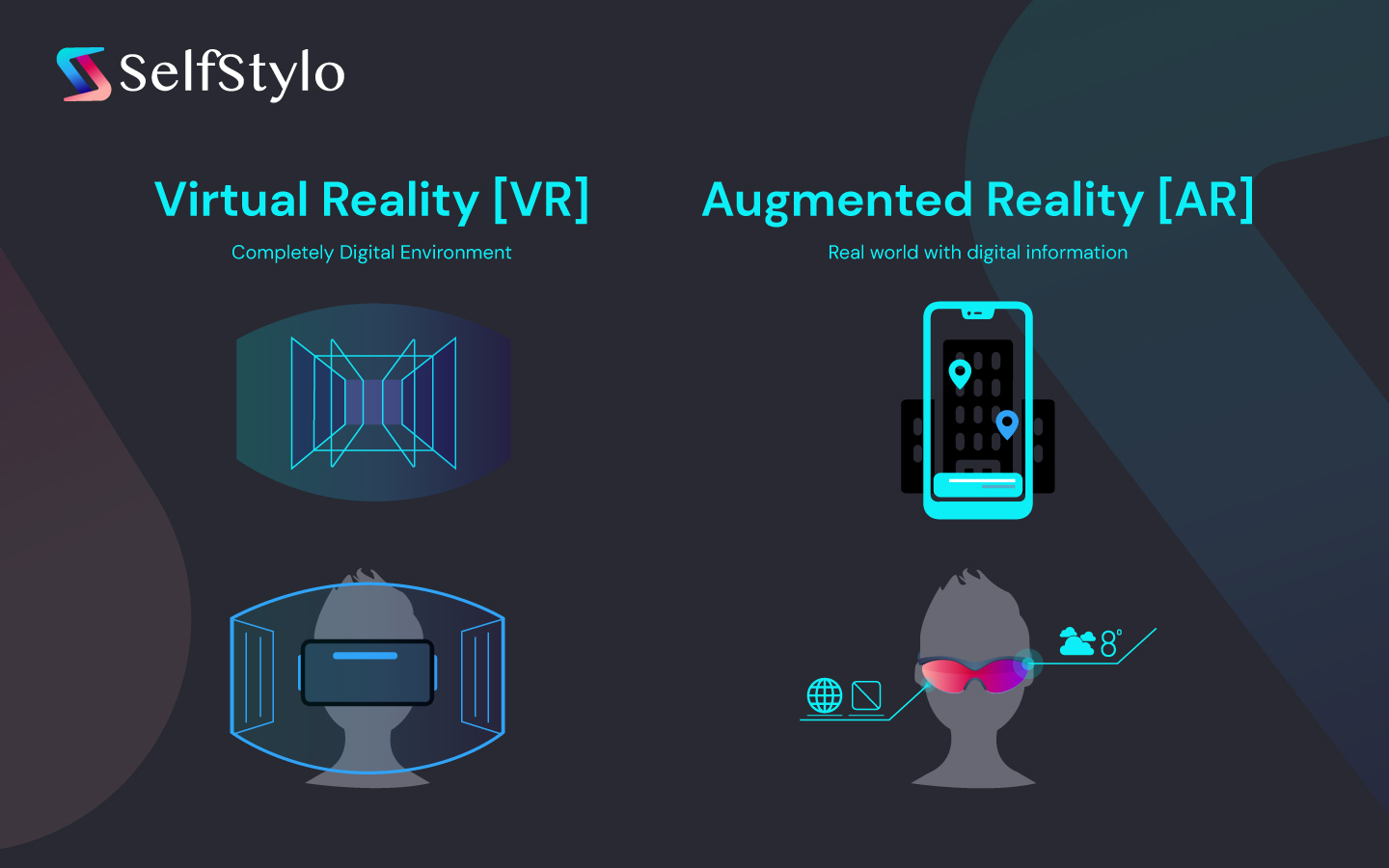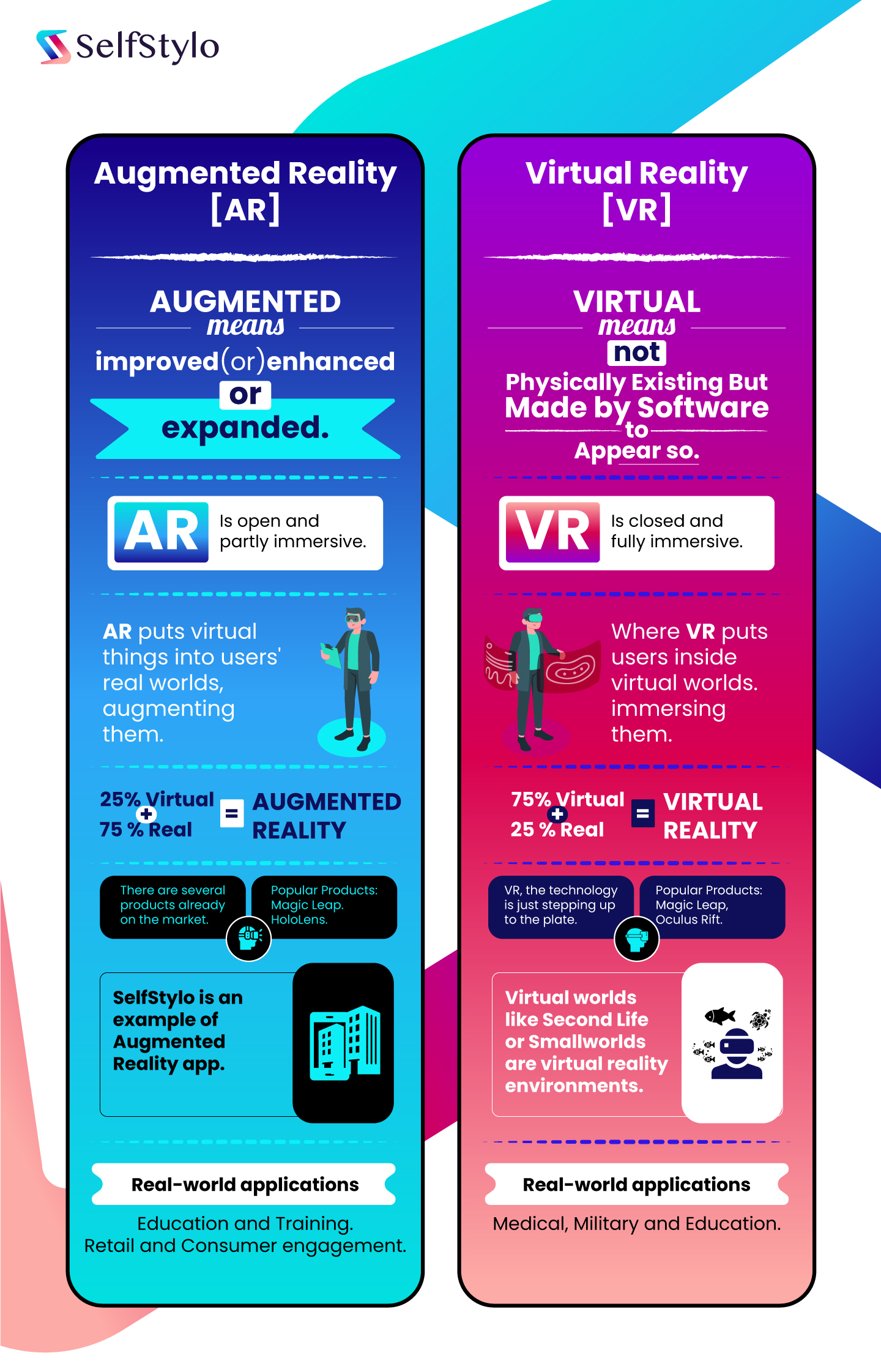AR vs VR has been in a rage lately. Learn how the two cutting-edge technologies differ in their basic definitions, examples, applications, and benefits.
With the high demand for AR and VR technologies in the fashion industry, many beauty and cosmetics brands are on the lookout for the best technology for their business. AR and VR aim to provide exciting new ways to engage customers and create immersive shopping experiences.
But the main question is: which technology is better for your fashion brand?
Well, both technologies come with pros and cons. From virtual try-ons to interactive product displays, there are myriad benefits of integrating tech into your business.
In this AR vs VR guide for beginners and brands, we will reveal how to take your business game to the next level using digital content. Let’s dive in!
What is AR or Augmented Reality?
According to Statista, the revenue in the AR and VR market is projected to cross US$31.12 billion in 2023, indicating the growth of both technologies. Augmented reality (AR) blends the physical elements in the digital world to create an artificial environment. One of the best examples of AR includes Pokemon Go. The AR game allows players to locate and capture Pokemon characters appearing in the real world. The core purpose of the technology is to display digital content in a real-life environment and offer a realistic experience to the user.
Advantages
- As no head-mounted display is required in AR, it offers endless possibilities for marketers to advertise their products.
- AR is growing faster, and many leading brands have implemented the technology to grow their business.
- AR is less technical and allows customers to visualize products realistically.
Disadvantages
- Developing your AR application from scratch can be a hassle for small and medium size fashion brands.
Applications
- AR technology can be used to create virtual try-on mobile experiences, where customers can try the product without physically touching it.
- Smart makeup mirrors are a unique and engaging AR use case that helps beauty enthusiasts try makeup before purchasing.
- Integrating AR apps with business websites enables online shoppers to try the brand’s entire product catalog without leaving their homes.
If creating an AR app from scratch seems challenging, consider integrating the SelfStylo AR application into your business. It’s easy to use, has a clean and user-friendly interface, and offers multiple features to make the shopping experience seamless for the users.
What is VR or Virtual Reality?
Unlike AR technology, virtual reality (VR) is a computer-generated simulation of an alternate reality or world. With the help of VR, users can enjoy a fully immersive experience in the 3D world and interact with the virtual world.
Advantages
- VR allows designers and shoppers to try as many styles and patterns as they want.
- Virtual reality is also used effectively in education to make learning comfortable and more accessible.
Disadvantages
- Virtual reality is costly compared to augmented reality and may not suit companies having budget constraints.
- It requires using VR headsets, leading to unnecessary time wastage.
- Compared to AR, VR involves technical complications.
Applications
- VR technology is an excellent tool for site inspections, 3D movies, etc.
- Brands can leverage the power of tech to create virtual demos and showcase products in an engaging way.
Differences Between Augmented Reality and Virtual Reality
Fashion brands and developers are adopting AR and VR in marketing, remote assistance, gaming, and many other fields. However, some may be unsure which technology is better than the other for their business. To help you understand better, we have covered the key augmented reality vs virtual reality differences in the below-mentioned table.
| AR | VR |
| AR is 75% real and 25% virtual. | VR is 75% virtual and 25% real. |
| No AR headset is required. | A VR headset device is required. |
| The technology provides a partially immersive experience to the user. | The technology provides a fully immersive experience to the user. |
| It is generally used to enhance both real and virtual world experiences. | It is generally used to enhance fictional reality in games. |
| The end-user is still in touch with the real world when they interact with the virtual objects. | The VR user is generally isolated from the real world and immersed in the fictional world. |
| Less expensive. | More expensive. |
| Suitable for users with little knowledge of technology. | Require technical knowledge to leverage the benefits of VR. |
Similarities Between AR and VR in Fashion
Though there are considerable differences between AR and VR, they share a few similarities too. For instance, both AR and VR utilize 3D content and holograms to let users experience the virtual world. Additionally, the main aim of both AR and VR in eCommerce is to improve the user shopping experience and keep them engaged for a long time.
Both AR and VR employ the same tactics in positioning and machine vision, sensors, haptics devices, lenses, controllers, motion tracking technologies, etc. Though both technologies offer immersive and interactive experiences to users, the choice between the two depends on the brand’s end goals.
AR Vs VR Examples Explained
Many companies and industries are already using AR and VR technologies, with fashion being one of the most prominent sectors.
IKEA developed The Place App to let users place furniture items into their homes before purchasing. The AR-powered application helps buyers visualize how a product will look in their setting. Hence, it reduces the chances of unsatisfactory purchases and improves sales.
Similarly, NIKE is leveraging the power of augmented reality in retail to let their customers scan shoes or clothing for more information. The fashion brand allows buyers to enter the VR world and experience different supply chain steps of manufacturing.
L’Oreal, in collaboration with Facebook, is using AR apps to enable their customers to virtually try-on makeup products and experience contactless beauty. Using their smartphone or tablet, customers can try makeup products from top brands, such as L’Oreal Paris, Urban Decay, Giorgio Armani, Yves Saint Laurent, etc.
Future of AR and VR in the Fashion Industry
If you want to choose AR technology to engage with customers and showcase products better, it’s vital to choose the right partner and integrate a feature-rich application. Not only will the experts help you understand the technical know-how of AR, but they will also help you creatively bring your products to life.
SelfStylo is one of the leading AR apps in the augmented reality market. You can integrate the application into your fashion business website and let your customers experience a new world of tech. Schedule a free demo with SelfStylo experts to understand AR vs VR and how the feature-rich app can help your business.



